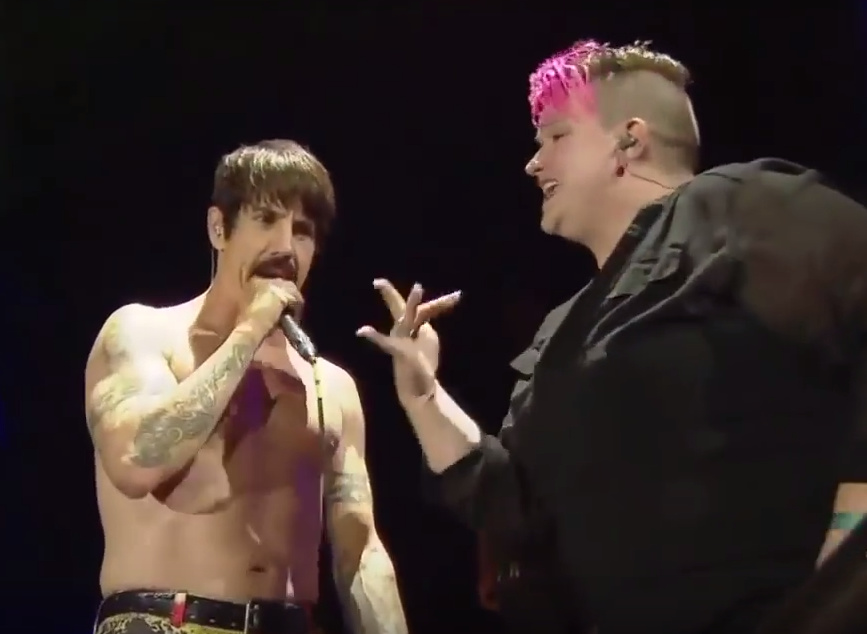Blog
-

INSIDE THE WORLD OF CONCERT SIGN LANGUAGE INTERPRETERS (A fascinating Insider’s view of a process many of us know little about).
 25 Aug , 2016
25 Aug , 2016
Report By Andrea Marks
At Firefly Music Festival in June, while thousands of fans watched Of Monsters and Men perform a daytime set, a few people were focused on the skinny blond man in the front corner of the stage. He was interpreting the songs in American Sign Language for deaf festivalgoers. He translated the lyrics, “We crawl, we crawl on the ground,” from “Six Weeks,” with a snarling facial expression and slow, desperate clawing motions with his arms.
ASL interpreters are becoming more commonplace when making major music festivals and concerts accessible to fans with hearing loss. Interpreters provide a service, giving ticketholders with a disability a more complete experience for their money. “It’s the equivalent of [having] wheelchair ramps, “ says Donnie Gibbons, who has interpreted shows for Phish and several iterations of The Grateful Dead, meaning he sees his job as a basic and essential amenity. However, unlike wheelchair ramps, signing songs requires months of planning and preparation to ensure interpreters are giving the audience what they want. No two deaf music lovers are exactly alike.
The deaf concertgoers I spoke with have to repeatedly explain (including to me) that yes, they enjoy music, and yes, they can hear it—at least some of it. Deaf people’s levels of hearing loss vary greatly, and thanks to advances in hearing aids and cochlear implants, it’s increasingly rare for someone to not be able to hear anything, especially at live concerts, where the speakers can blast sound at over 100 decibels.
Bill Boyland, for example, a letter carrier in Albany, New York, was born deaf and is a lifelong music fan. He grew up detesting his parents’ country music but would borrow his sister’s record player to play Van Halen and Aerosmith albums when she wasn’t home. He likes the sound of the drums, guitar, and vocals, but he struggles to catch all the words.
“When I would buy the records of the different bands I like, the most exciting part was that they had the lyrics in the record case,” he says, speaking through an interpreter by video call. “I would sit and listen and read along with the lyrics over and over and over again to get to know the music and understand what they were saying very clearly.”
At a distortion-heavy rock show, even fully hearing audience members struggle to decipher the words. So for some deaf patrons, interpreters are there to help fill in the blanks that lip-reading cannot.
Others may just hear the bass and feel the vibrations, so seeing the words or meaning of the song adds another facet to their live music experience.
Since the Americans with Disabilities Act passed in 1990, concert venues or production companies have been required to provide interpreters upon request. Boyland has contacted Live Nation to request interpreters for five shows over the last two years.
Some organizations specialize in hiring out interpreters for events—Red Frog Events, the producer of Firefly, relied on a company called Accessible Festivals, which also provided interpreters for Coachella and Electric Daisy Carnival in Las Vegas and New York City this year—but oftentimes it’s word-of-mouth that connects an interpreter with a company that needs one. Ticketholders can even request an interpreter by name. That’s how Gibbons has become a regular for Phish and The Dead.
It helps that he was a fan to begin with. “I tend to stick with the acts that I know and that I like,” he says. “That makes the whole job easier and the experience a lot better.”
He connected another interpreter, Kelly Sosebee, who works with him at The Learning Center for the Deaf in Massachusetts, with some jobs he wouldn’t have been keen on: metal lineups that have included Slayer, Slipknot, and Lamb of God. Sosebee agrees loving the band is a prerequisite for interpreting their concerts.
“You’re invested in the music because you like the music already,” she says. “If a pop band came around, or rap—those are genres I’m not a huge fan of, so I know there’s another interpreter out there who would be a better fit.”
Even for a favorite band, however, interpreters start preparing weeks or even months before a show, playing the band’s music on repeat until they know the songs as well as the lead singer. Gibbons says he is comfortable when he can “name that tune” in three notes or fewer. “We have to be like, extreme fans,” he says.
Getting a set list helps, too. Sometimes the band will provide them to the production company ahead of time. When that fails, there’s always the internet. Sosebee uses a site called setlist.fmwhere users share set lists from shows. If a band’s been on tour for a while, she says, you start to get a good idea of what they’re bringing to the stage. Gibbons relies on online resources, too, but it gets more complicated with bands like The Grateful Dead, who are known for never playing the same show twice. “If they play the night before, we know none of those songs will be on our set list,” he says. By looking at recent shows, he can begin guessing what he’ll likely hear based on what hasn’t been played.
After an interpreter has narrowed down a set list and memorized the lyrics, they need to establish whether they’ll be signing the words or ideas, or a mix. American Sign Language is its own language with its own grammar, syntax, and semantics that include visual elements like facial expressions and use of space to show meaning, emotions, and relationships. It is more ideas-based than an exact English translation. That’s possible to do in sign language, using finger spelling and other signs, but it’s not the same thing. Depending on the audience, an interpreter might stick to one, the other, or a combination. Gibbons and Sosebee reach out to the ticketholders who requested the service to ask what they prefer. “I like to know who their favorite bands are, who they’re most excited to see,” says Sosebee. “That gives me a bit of a focus, energy-wise.”
A fan like Boyland, who can hear the music pretty well with the help of a hearing aid, needs an interpretation that keeps up with the tempo of the song and fills in the words he misses. Somebody else might be hearing mostly bass and feeling vibrations through the ground or inflatable balls or balloons they’re holding. They might prefer an interpretation that captures the full emotional range and message of the song. For these fans, hitting the downbeat and presenting all the lyrics may be less important.
Oftentimes a mix works best. Gibbons says if he interpreted the Rolling Stones’ “Satisfaction,” for example, he would be inclined to sign the exact words “I can’t get no” right on the beat so members can sing or sign along and feel the rhythm. During the verse, however, he’d be more likely to sign the idea of “When I’m driving in my car,” rather than capturing the words.
Some songs, however, aren’t that straightforward.
“Unfit for Human Consumption” by Carcass posed a major challenge for Sosebee, a seasoned metal fan. The song opens with these lines: “Seductive lymphandetitis / Delectable septic metritis / Tempting glanders jaundice / For human consumption unfit.” And the rest of the four and a half minutes is similarly multisyllabic and grotesque. Where most listeners could just headbang along to the death growling and fast-picked arpeggios without thinking too hard about the words, Sosebee had to draw more concrete conclusions about what they’re singing about. “I believe the intention of the band is to kind of gross you out,” she says. “It’s this mix of sexuality with medical terminology. It’s describing decaying body parts.”
She Googled the words she didn’t recognize to see if there were any clearly sign-able diseases in there. “Some of it could be very visual like, let’s say, a pussing wound,” she says. “That’s something I can make very visual with sign language.” Sosebee could have finger-spelled the more complex medical words, but that would slow down her performance without explaining what any of it meant. It would give the viewers a word equivalent but not what’s known as the message equivalent. “You don’t know what melanosis is, but as a listener, you’d recognize that these are diagnoses because they sound like it,” she says. “It’s a pretty strong feeling you’re going to get from these lyrics.” So she made sure that feeling came across, using her whole body and facial expressions to capture the visceral nastiness of ideas like “Diseased gastric dining” and “Aromatic mastitis.” “The deaf person watching it is going, ‘Ooh this is a little disturbing.’” In other words, mission accomplished.
Once the interpretation is decided, it’s like rehearsing a dance. “You just practice your ass off over and over again until it becomes second nature,” Sosebee says.
At the show, interpreters usually work in teams, switching off to give each other breaks and to make sure the person who knows the song best is the one signing.
The ideal setup includes a lit music stand so they can see their notes and lyrics and prop up their iPad and a light on them so the audience can see them. If the place is really top-notch, they’ll get a vocal feed to plug headphones into. That’s the only chance they have of hearing the singer, because they are usually right in front or to the side of the speaker stacks.
If Gibbons gets thrown a curveball during a show, he will sign to what he calls his super fans—deaf audience members who are even more expert at identifying songs—asking them what’s playing. Then he can pull up the lyrics and do his best to improv an interpretation.
Boyland says the best signers he’s seen bring efficiency, energy, and drama to their interpretation. Sometimes, it can border on its own performance. He recalls a particularly adept interpreter at a recent Disturbed show. “One of my favorite songs is ‘Sound of Silence,’ and that interpreter was signing along very beautifully and very smoothly because it’s a slow song itself, so in that way, I think that was a form of art because she did such an amazing job interpreting.”
Such performances capture the attention of hearing audience members, too. Videos of one well-known interpreter, Amber Galloway Gallego, went viral, because viewers were amused to see the woman with a shock of pink hair aggressively signing Kendrick Lamar’s lyrics, “Pussy and Patron make you feel all right.” (Gallego, seen in this post’s image).
But ASL is not a novelty, Sosebee says. It’s a language like any other, with a necessary added element of performance when translating music. She gets why interpreters are fun to watch at concerts, but she hopes people remember they are at there to serve a minority community. “Sometimes the attention it gets is more just on the surface as far as, ‘Oh that looks cool,’ or, ‘Look at the funny faces they’re making,’” she says. “If it’s something that piques your interest, it’s worth learning more about.”
Boyland, who has plans to see an interpreted blink-182 show later this year, isn’t concerned about who’s watching the interpreter, as long as he gets to enjoy himself. “The interpreters are just doing their job,” he says. “They’re following the words. It doesn’t matter if they’re swearing or not. If people think that’s cool, that’s fine. That’s up to them.”
Source: Noisey.vice.com, Reporter Andrea Marks
Image credit: Youtube screen shot of Amber Galloway Gallego.





























































































































































































































































































































































































































































































































































































